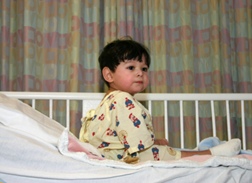Doctors often can identify Stevens-Johnson syndrome based on your medical history, a physical exam and the disorder's distinctive signs and symptoms. To confirm the diagnosis, your doctor may take a tissue sample of your skin (biopsy) for examination under a microscope.
No specific laboratory studies (other than biopsy) exist that can definitively establish the diagnosis of Stevens-Johnson syndrome.
- A complete blood count (CBC) may reveal a normal white blood cell (WBC) count or a nonspecific leukocytosis. A severely elevated WBC count indicates the possibility of a superimposed bacterial infection.
- Skin and blood cultures have been advocated because the incidence of serious bacterial bloodstream infections and sepsis contribute to morbidity and mortality.
- Determine renal function and evaluate urine for blood.
- Electrolytes and other chemistries may be needed to help manage related problems.
- Cultures of blood, urine, and wounds are indicated when an infection is clinically suspected.
- Bronchoscopy, esophagogastroduodenoscopy (EGD), and colonoscopy may be indicated.
Chest radiography may indicate the existence of a pneumonitis when clinically suspected. Otherwise, routine plain films are not indicated.
Skin biopsy is the definitive diagnostic study but is not an emergency department (ED) procedure.
- Skin biopsy specimens demonstrate that the bullae are subepidermal.
- Epidermal cell necrosis may be noted.
- Perivascular areas are infiltrated with lymphocytes.
Although the clinical presentation and patient history usually make the diagnosis of TEN evident, other conditions should be considered in the differential diagnosis - mainly in the early stages of disease when the complete picture may not be obvious. The differential diagnoses for TEN include SSSS, acute graft-versus-host disease, linear IgA dermatosis, paraneoplastic pemphigus, pemphigoid and pemphigus, and AGEP.
< Causes Treatment >





 12:44 PM
12:44 PM
 bolty
bolty



